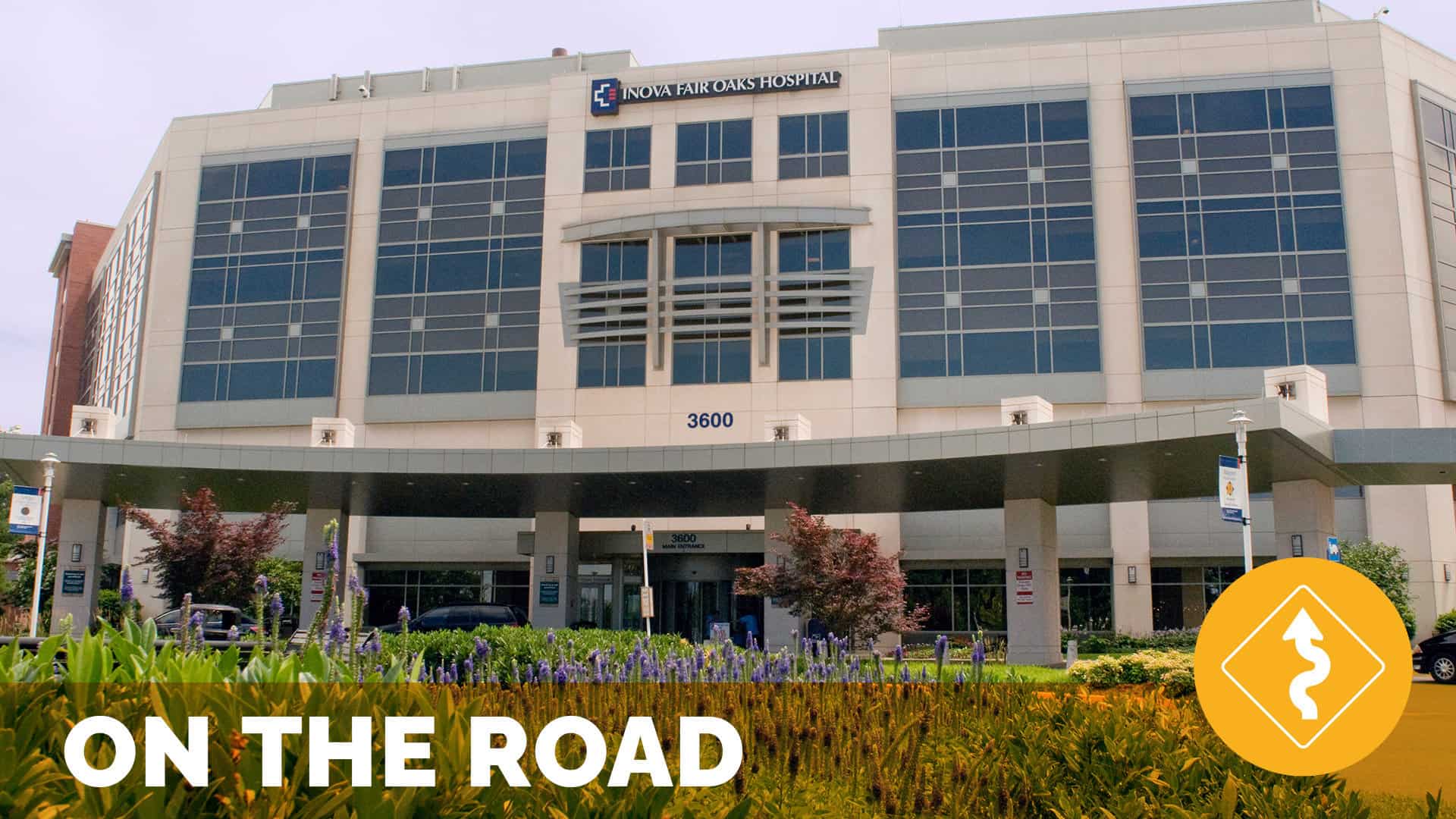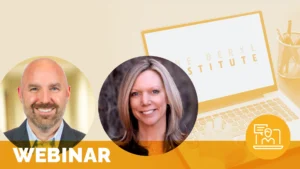The Patient Experience Journey: From Warm Welcomes to Fond Farewells

On the Road with Inova Fair Oaks Hospital – August 2011
by Jason A. Wolf
Our latest On the Road took us to Inova Fair Oaks Hospital (IFOH), just minutes from Washington, DC. With the cacophony and chaos inside the Capitol Beltway these days, the quiet and calm of IFOH played a stark contrast. After passing the hellos of the valet staff, I entered the lobby where I was not only welcomed by a warm and pleasant environment, but also actually greeted by a person. There she stood, a cheery IFOH Greeter, whose job it is to ensure guests make it safely to their destination. The key here is not that they inform us of how we get there, but take us to where we need to be.
Lobby MonitorsIn looking around, the general jitters you expect to sense in people entering a hospital lobby seem blanketed by the confidence offered through clear signage and monitors showing IFOH’s recognition as a Center of Excellence in numerous specialties [pictured right]. Adding to the atmosphere was the bustling activity of a volunteer-run auxiliary bag sale taking pace in the adjoining atrium with customers that included patients, family members and staff. The last element was something I almost missed at first, piano music – not piped over hidden speakers, but actually emanating from a baby-grad player piano just to the back of the lobby area. I was reminded of how Colleen Sweeney, with Memorial Hospital and Health System, always stresses the importance of the first three seconds in setting the stage for any experience.
The Patient Experience Journey
The first moments of my experience set the tone for an insightful exploration of what has led to IFOH’s patient experience success. In fact, right off the lobby in the entrance to the cafe I saw something I have yet to see on any other visit – the Inova Fair Oaks Hospital Patient Journey. There it was in plain sight, a poster outlining the key steps of the patient experience for patients and families at IFOH [click here for larger version]. The journey is based on the facility’s shared beliefs and is composed of six major milestones including:
- Planning the Journey
- Warm Welcome
- Lay of the Land
- Itinerary
- Daily Activities
- Fond Farewell
Each milestone included the key practices and processes that supported its success for all to see. This sign represented the most transparent and intentional patient experience commitment I have ever experienced. Moreover, this was not the only place I was to see this sign. It was strategically placed around the facility where patients, family and staff can be reminded of this important focus.
While I will not spend this article describing every component of the journey map, it serves as a model for where strategy and tactics around improving the patient experience can be integrated. (I suggest you review how IFOH has aligned key actions at every step along the way.) It also represents the very intentions of how we at the Institute worked to define the patient experience as the sum of all interactions, based on an organization’s culture, that shape patient’s perceptions across the continuum of care.
The definition is especially relevant here for two reasons. One because it is clear that IFOH understands that the experience starts well before and continues well after the clinical encounter. The first milestone on the road map is Planning the Journey and the commitment is “No Surprises!” in which patients are well prepared and cared for prior to ever entering the facility. The commitment of the final milestone Fond Farewell is “Lasting Personal Connection”. This step does not end at discharge, but is extended through post visit phone calls, support groups and other means. Through this map, the full continuum is exemplified.
The second reason the definition is relevant is that in every encounter I had, from my tour, to spontaneous interaction with staff, to my extended conversations with senior leadership, the discussion of the tactics of impacting patient experience was secondary. Rather, what I heard from all I met was that the culture of IFOH is at the foundation of their patient experience success. It is the organizational commitment they have created based on their shared beliefs (which also run right along the center of the patient experience journey map) that supports their overall success. As Marie Dennis, Chief Nursing Executive, a 30+ year staff member of the facility said, “there is something special here, you can feel it as soon as you walk in the door.” I certainly did!
It is important to note that Inova Fair Oaks Hospital’s achievements equate to much for than a feeling. IFOH consistently performs in the top quartile of the PRC normative database for patient perceptions of the cleanliness of the hospital and more importantly for overall quality of care. These results have translated into measurable patient loyalty as evidenced by consistently high Hospital Consumer Assessment of Healthcare Providers and Systems (HCAHPS) scores for the domain “likelihood to recommend”. They have scored between 79% – 82% on this domain since the start of HCAHPS public reporting and sustained performance over the 80th percentile nationally. They attribute these results to the culture and patient experience efforts started well before HCAHPS was initiated. Of equal importance and I am sure of great interest to those asking the question on how to best engage physicians on the patient experience journey, IFOH has been the top performer in PRC’s normative database for medical staff perception of place to practice medicine for the past three years as well.
Beyond Expectations
Recognition
After my initial experience in the lobby, my visit to IFOH began with an extensive tour of the facility to see the Patient Experience Journey in practice. My guides, Tracy Dean, Physician Liaison at IFOH, and Anne Hooper, Director of Service Excellence for the Inova Health System, helped show how they put the words on the wall (both the Patient Experience Journey and the Shared Beliefs) into action [pictured right]. We immediately encountered a recognition box hanging just inside the café where staff, patients or family members could recognize someone for exemplifying a shared belief through their actions. Those recognized over time earn pins for their efforts, with 1 to 4 nominations resulting in a silver pin, over 5 nominations, a gold pin, and over 10, a platinum pin. I lost count of how many staff I saw with pins on their badges. This simple process helped to reinforce that the shared beliefs – the foundation of culture at IFOH – are much more than words on the wall.
Focus and Transparency
As we travelled the halls and visited many units, I was struck by a number of consistencies and personal touches to impact the experience. First, in another sign of transparency and exemplifying a commitment to excellence, I did not see a unit or department in the hospital that did not have a pillar board displayed focused on their performance goals or sharing information on the key IFOH pillars. The areas of focus were not different from those I have seen at other hospitals – Quality, Service, Cost, People, Growth and Community [pictured below]. What stood out was the consistency with which information was shared not only showing unit objectives and performance, but also including key educational information for both patients (and their families) and staff.
Equally impressive was that every unit we visited had a wall of pictures of their staff posted right near the main nursing station [pictured above]. Some of these boards had pictures with names, others with fun facts or other information. These boards provided a personal touch for patients and families. Staff and nurses became people with names and stories; units were transformed from settings simply focused on clinical encounters to communities.
It was clear that units worked on managing the expectations of patients and families. A great example was shared by Emergency Department (ED) Director Deborah Fulbrook, who spontaneously took a few minutes to walk us through the ED. First, the ED serves as a pilot site for staff engagement around process improvement efforts (part of an expanding lean initiative across Inova Health System). Staff is invited to offer suggestions and drive projects aimed at process improvement through the ED. This is done through the use of a huddle board. One idea that emerged was an info sheet provided to all patients who come to the ED to help them understand what to expect during their visit. This document provides patients a sense of what they will experience while in the ED and allows for an effective management of their overall ED journey. [View the ED flyer]
Cleanliness and Clutter
As Tracy led me through hallways both in front and in back of the house, I felt like something was missing. Then it hit me, the typical clutter of stored beds, IV poles, or wheel chairs were almost non-existent. Hallways were open and the feeling of clean was at every corner. I learned of the highly committed housekeeping staff that not only ensured quick turns and clean rooms [pictured left], but were also leading contributors to the culture.
They shared a story about Chip the housekeeper who is a floor care expert. I was told this story is now part of the IFOH lore. Chip was working on the 3rd Floor OB Unit when he encountered a gentleman pacing, looking stressed and sad. Rather than just continuing to work on the floor, Chip stopped and asked the gentleman if he was ok. The gentleman shared the story of the stresses around his wife’s pregnancy and then Chip responded by saying “I just want you to know you have the best doctors and people here taking care of your wife.” That simple encounter of caring relieved the man’s tensions and positively impacted his experience. The gentleman submitted a recognition card and shared the story of how Chip’s reassuring words provided him the relief he needed at the moment he needed it most and ensured an excellent experience. Chip’s story exemplifies the all hands accountability expected from members of the IFOH staff.
Another aspect of cleanliness comes with CEO John Fitzgerald’s “Mr. Clean Rounds”. While focused on unit cleanliness, John, along with his Director of Facilities and Environmental Services Leader use these visits to thoroughly examine a unit and engage with staff. John literally will run his fingers along doorframes, examine air vents for dust or ceiling tiles for cracks or stains. These actions are meant to exemplify the expectations he has set for everyone in the facility to be accountable for the space in which they work. These are also opportunities to connect with staff on the issues they are facing, gather input, ask questions and share news. “Mr. Clean Rounds” exemplify how even in the tactical efforts to create constant improvement, there is a reinforcing effort on sustaining the culture at IFOH. In my conversation with John he shared what I believe exemplifies the nature of the patient experience effort at IFOH, “Patients expect us to get it (the care encounter) right. That is a given. What they are looking for is compassion and trust. We are helping them through what might be one of the most difficult parts of their lives.” It is this stepping beyond expectations that exemplifies the service culture of Inova Fair Oaks Hospital.
A Framework for Action
Over lunch, I asked John to frame what he saw as the key steps in IFOHs journey. He came right back to the culture of the organization and the foundation of shared beliefs. “We had to start there,” he said, “before we could build a plan of action.” In fact in living the shared beliefs John and his team eat lunch in the café every day to engage with staff, patients and others in the facility.
The next step he offered was ensuring the right leaders and the best people. If the organization is going to move beyond expectations, to compassion and trust, you need people that will help live those beliefs every day. He offered that if people are not performing you have the opportunity to coach them up or out. He shared the sentiment that we do not have time for “angry people” or attitudes in our staff when every care encounter is critical. “There should no room for error in either quality of service,” he added.
John recognizes strong physician relationships as another key component. This starts with having breakfast in the physician lounge every morning. Being in regular communication with physicians and engaging them in what the facility is trying to accomplish is key. When physicians realize they play a bigger role and have a greater influence than in just the clinical encounter, they become a more valuable contributor to overall facility efforts. They too become part of the experience equation.
A central key to the patient experience journey John Fitzgerald suggested was a core service concept. These are the key words that help explain your commitment to patients. The service concept is something lived versus simply posted on a wall and is exemplified by the actions of leadership and reinforced through the behaviors of staff. John said they are still on their journey to define this concept, though it was clear from my visit this has not deterred staff at all levels to live and act with a service mindset every day.
The Foundation of Culture and a Case for Humility
As I wrapped up my visit I had the chance to spend time with additional members of the senior team, Marie Dennis, Chief Nurse Executive, Teddy Riche, AVP and Service Pillar Leader, and Fadia Feghali, Senior Director of Clinical Operations. When I asked about what supported their journey to service success, the response almost came in unison, “none of this would have happened without our culture.” With that they shared a few key lessons.
- You have to first address your issues of safety and quality before you can address satisfaction and service.
- You can try all the service tactics you want, but you first need the foundation of a strong culture on which to build.
- Staff has to feel cared for before they can provide the kind of caring or service experience themselves.
The last point was exemplified in a story shared by Fadia about the turnaround she lead in one of the facility’s lowest performing units. She told about how she worked to reengage the team in what was important for the unit, not in starting with what they needed to do, but understanding why they were not able to do it. By engaging the staff at a level of caring and as she described, “triaging for the critical issues and prioritizing needs” she was able to refocus the negative energy into positive purpose. Fadia was clear in saying, “This was not easy to do. It required persistence and consistency.” But it was that persistence that allowed for the actions that followed. As she said, “Once you reengage the staff, the sky is the limit.” The unit quickly identified priorities and moved from one of the lowest performing to one of the highest performing in the facility.This story addressed something I am often asked; does culture magically occupy every corner of an organization? My normal response and this case both show that the answer is “not always”. Rather it takes committed leadership and team effort everywhere to initiate and sustain success. It also reinforces the emerging message from my visit to IFOH, that it is the foundation of culture that drives success. Or to play on a well-known quote, if culture eats strategy for lunch, imagine what it does to tactics.
These lessons were also supported by the notion shared by Anne Hooper in how we all too often use metrics and application of tactics as our goals and overlook the foundational efforts. She suggested, “When we tell staff we want to be at the 90th percentile as a goal, what does that really mean? We need to create the right organizational foundation and clarify the desired actions so staff at all levels know what they need to do.” The key I saw at IFOH was in the doing. It was evident that the people of IFOH were both clear about what they needed to do and also were aware of the impact of their actions.
In all of my journeys, from studying high performance healthcare organizations to determining what drives HCAHPS success, I have found a common characteristic of those that outperform. It is an overwhelming sense of humility that even in the face of successful efforts and great accomplishment prevails above all else. When I asked the leadership team if they have achieved what they intended through their efforts, the response was immediate, emphatic and consistent. Ted Riche said, “This is a continuous journey. You never get to a place where you can say you are there”. Marie Dennis added, “Agreed, we are never really there. And in fact I am worried every day about losing it.” These are strong words from a team of senior leaders who show they are committed to the ongoing effort and support it takes to ensure sustained success in creating unparalleled experience and building a vibrant organizational culture.
Fond Farewell
It is fitting that the Fond Farewell milestone in the IFOH Patient Experience Journey talks about lasting personal connection. This represents the true intent of what I experienced at IFOH from my first three seconds in the lobby to my departure when I paused to take in the tunes emerging from the player piano [pictured right], the auxiliary sale still buzzing with activity. From my very first conversation with staff and leadership on how they address the patient experience, the topic went where it does not usually go.
Rather than discussing the tactics of a patient experience effort, we were talking about the nature of the people, the importance of the shared beliefs, the clean and uncluttered environment, and the unwavering support of leadership. This sense of pride in who Inova Fair Oaks knows it is and has proven itself to be through its performance emerged as the central message from this visit. The Patient Experience Journey framed the conversation and rather than discussing specific actions and tactics under each milestone, it was the nature of the organization itself, its culture, that took center stage.
My thanks to the leadership team and staff of Inova Fair Oaks for their welcome and hospitality. The issue of culture and the patient experience is a critical one and well shaped by the efforts of this focused team.
Related content
-
 Culture & Leadership | Infrastructure & Governance
Culture & Leadership | Infrastructure & GovernanceReturn on Human Experience: Eight Principles to Inspire Excellence in Healthcare
Join Jason Wolf and Stacy Palmer, authors of Return on Human Experience: Eight Principles to Inspire Excellence in Healthcare, for a conversation on transforming the human experience in healthcare. At its core, healthcare is human beings caring for human beings—yet the complexities of quality, safety, service, cost, and outcomes often pull organizations in different directions.
Learn more -
 Culture & Leadership
Culture & LeadershipLeading in Turbulent Times: Why Experience is Essential to Healthcare’s Future
Healthcare systems around the world and throughout our community are being buffeted from all sides, with higher acuity patients, a vulnerable and stressed workforce, unsure finances and support structures, and even challenges to long-held medical truths. For as much as we traversed a once in a lifetime moment through the pandemic years, the residual effects
Learn more -
 Culture & Leadership | Patient Family & Community Engagement | Staff & Provider Engagement
Culture & Leadership | Patient Family & Community Engagement | Staff & Provider EngagementA System-Wide Transformation in Human Experience at NSW Health
Global Headliner Webinar Series (Complimentary) – Join us as we reflect, reconnect, and recommit to elevating the human experience—not as an initiative, but as a way of being. Tuesday, August 19, 2025 10:00 PM EDT – Eastern Daylight Time (New York) Wednesday, August 20, 2025 12:00 PM AEST – Australian Eastern Standard Time (Sydney, Melbourne,
Learn more
